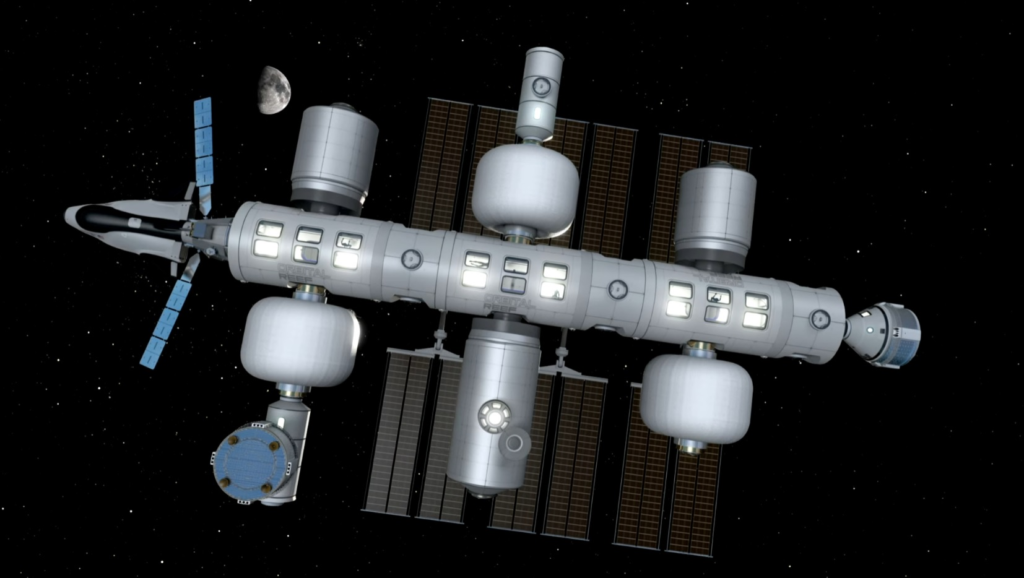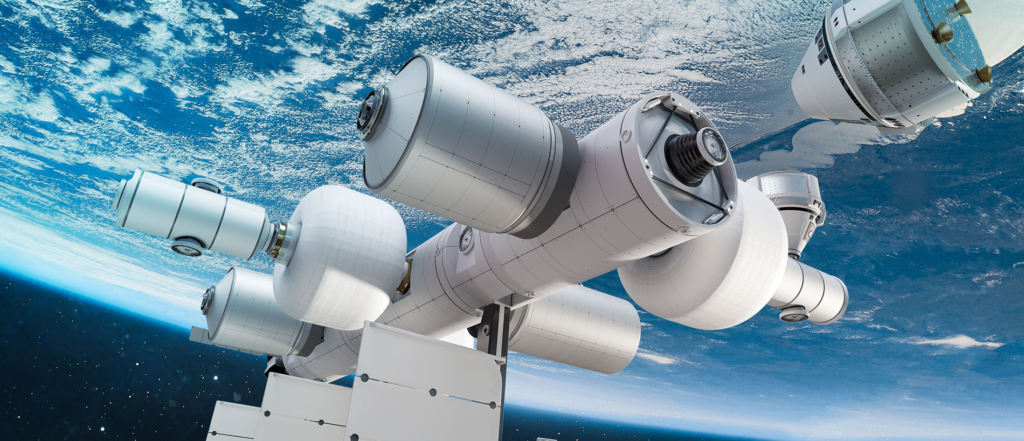
Will Orbital Reef Really Be Operational In Only 5 Years?
Now more than ever before, a host of companies are working on destinations in space rather than just vehicles to get there. A great example is Orbital Reef, an ambitious commercial space station led by Blue Origin and Sierra Space, with a host of other companies part of the overall team as well. However, a project this big involving so many different pieces begs the question of whether or not it will be completed in a timely manner.
To put it in perspective, the Orbital Reef station relies on multiple significant projects each with its own unique challenges and respective timelines. Some primary examples include Blue Origin’s New Glenn, Sierra Space’s LIFE Habitat, Dream Chaser Spaceplane, and much more. All of which impacting the future of this station as one single problem could delay the entire project.
This being said, the main companies involved are working hard to avoid this fate and make sure their contributions are fully capable and on time. Here I will go more in-depth into some of the main projects Orbital Reef relies on, any progress being made, what to expect in the future, and more.
2027 Deadline

In a recent report from Orbital Reef, they highlighted that the station is expected to be operational by 2027. Being that we are only a couple of months away from 2023, this deadline is not far away at all. In order to get a better idea of what the project relies on and everything that needs to be completed prior, we can focus on the main station contributors. Starting with Blue Origin which is responsible for utility systems, large-diameter core modules, and the heavy-lift New Glenn launch system. In terms of a future launch date it’s partially unclear due to a variety of factors. Based on current progress and some good news regarding the engines and delivery to ULA, the company is getting closer to a first launch. This being said, there are still a lot of unknowns and Blue Origin has a lot of testing necessary in conjunction with the development of the launch vehicle, booster landing site, and more. Based on all these components, the first launch of New Glenn likely won’t be until 2024 or even 2025. If this is the case it cuts it quite close with Orbital Reef as this rocket is necessary to send the segments and core features of the station.
Next is Sierra Space, responsible for the Large Integrated Flexible Environment (LIFE) module, node module, and runway landing Dream Chaser spaceplane for crew and cargo transportation. While Boeing is part of the project with the addition of Starliner, Dream Chaser is excepted to be the main transportation option for future crews heading to and from Orbital Reef. While this spaceplane is very unique and offers quite a few different benefits, its development has not been the fastest. Specifically, Dream Chaser was originally announced almost two decades ago in 2004. Since then it has gone through multiple companies and has been worked on each year. Currently, its first scheduled launch is not far away scheduled in 2023 on top of a United Launch Alliance Vulcan Centaur. It’s important to point out however that this mission will be uncrewed, and in reality, the first crewed launch isn’t expected to happen until 2026. This one factor will most definitely have an impact since delays between now and then are very likely. Thankfully in terms of Orbital Reef’s schedule, there are other options for transporting humans to and from the station if need be.
The other big contribution is Sierra Space’s LIFE module. The LIFE habitat is 27 feet in diameter and 27 feet long. The LIFE habitat’s pressurized volume is 300 cubic meters, or about 1/3 of the pressurized volume on the International Space Station. While Sierra Space hasn’t released a specific date this project will be ready, in a recent report, they highlighted that the first LIFE habitat will be ready for voyaging into Earth’s orbit within the next few years. Then, it’s only a matter of time before subsequent habitats launch, opening up novel opportunities to connect multiple LIFE modules into larger space stations to support living and working in space. Recently we saw a few tests of a scaled down LIFE module that reportedly went very well. A good sign for the modules expected to provide a good majority of space within the station. While there are other projects involved in the future of Orbital Reef, these three are the most important. In order for this station to be operational in 2027, they all need to stay on schedule and even speed up partially in some cases. Realistically, since Orbital Reef relies on multiple significant projects, we might have to wait until later in the decade around 2029 or 2030 before it’s filled with people.
Project Overview

Now that we know more about the companies involved and some of the project deadlines that Orbital Reef relies on, we can take a closer look at the station itself and some of the progress it has made. As you can imagine there are a lot of steps and checks needed for the plan before you can place a space station in low Earth orbit. Earlier this year in April they announced the Orbital Reef team had successfully completed its Systems Requirements Review (SRR) in just three months. The SRR is an important program milestone marking the baselining of the requirements for the mission and design of Orbital Reef, a commercially developed, owned, and operated space station to be built in LEO. The SRR reviewed Orbital Reef specifications to ensure they reflect the current knowledge of the mission and market requirements to serve as a stable baseline to proceed with development. The Orbital Reef team, including Boeing, Redwire Space, Genesis Engineering Solutions, Amazon Distribution & Fulfillment Solutions, Amazon Web Services and Arizona State University, is maturing the design of its space station in partnership with NASA under the agency’s Commercial Low-Earth Orbit Development (CLDP) program. NASA awarded the agreement in December 2021 to shift NASA’s research and exploration activities in LEO to commercial space stations and help stimulate a growing space economy.
Specifically, the review assessed Orbital Reef’s ability to meet safety and mission requirements and evaluated the technical readiness of the design, the concept of operations, the feasibility of project development plans, and planned verification activities. Representatives from Blue Origin, Sierra Space, team members, and NASA participated in the review, which was conducted virtually.
Months later in August, they announced the team had successfully completed its System Definition Review (SDR) with NASA. The SDR included an extensive review to ensure that the proposed Orbital Reef architecture is responsive to the functional and performance requirements; it examined the proposed system architecture and the flowdown to all functional elements of the Orbital Reef system. The successful SDR supported NASA’s decision to further develop the system architecture and design. Representatives from Blue Origin, Sierra Space, team members, and NASA participated in the review, conducted between mid-June and mid-July to allow in-depth review of documentation and feedback to the team.
At the time of this announcement, Tom Vice, CEO of Sierra Space commented, “We are on the doorstep of the most profound industrial revolution in human history. An industrial revolution marked by the transition from the last 60 years of space exploration to a future where humanity extends our factories and cities into space. It isn’t solely about tourism – it is about unlocking the next great discoveries using the microgravity factories that we will build just 250 miles above the Earth’s surface. The microgravity factories and services provided by Orbital Reef have the potential to revolutionize every industry and become a major growth contributor to the U.S. and world economies.” In addition, Brent Sherwood, Senior Vice President of Advanced Development Programs at Blue Origin said, “This SDR moves Orbital Reef forward. We are meeting the needs of both the commercial marketplace and NASA’s requirements. Orbital Reef will change the game for human space flight in Earth orbit.”
Orbital Reef is expected to open the next chapter of human space exploration and development by facilitating the growth of a vibrant ecosystem and business model for the future. Designed to open multiple new markets in space, Orbital Reef will provide anyone with the opportunity to establish their own address in orbit. This unique destination will offer research, industrial, international, and commercial customers the cost competitive end-to-end services they need including space transportation and logistics, space habitation, equipment accommodation, and operations including onboard crew. While very ambitious, and by no means easy, the companies involved are confident in this project and are working on the various technology it needs to succeed. We will have to keep an eye on both Blue Origin and Sierra Space in the future as they work toward this commercial space station.
Conclusion
Orbital Reef is a large space station expected to be operational by only 2027. This aggressive timeline brings up the question of whether or not a complete station toward the end of this decade is realistic. Currently, both Sierra Space and Blue Origin are working on the necessary projects including New Glenn, Dream Chaser, and the LIFE Habitat. We will have to wait and see how it progresses and the impact it has on the space industry.
